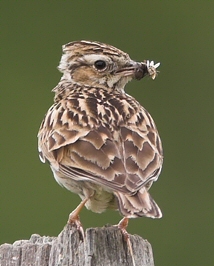|
Woodlarks are returning to breed on England's
farmland in greater numbers than at any time in the last 40 years.
A new national survey has found woodlark numbers in the UK have
risen by 89 per cent in the last 10 years. The rise has been
driven by work to provide suitable habitat – improvements to the
size and condition of lowland heaths and good management of
forestry plantations.
Increasing numbers of the birds now appear to be moving on to
farms to breed, with many nesting on set-aside land. There are
fears, however, that the imminent loss of set-aside - because of
changes in the way Europe pays its farmers - could limit the
woodlark's spread unless suitable alternatives are provided.
The results of the survey, carried out by the British Trust for
Ornithology (BTO), RSPB, Natural England and the Forestry
Commission (England), show an estimated 3,084 breeding pairs of
woodlark, compared with 1,633 pairs in 1997 and the low point of
just 241 pairs in 1986.
Traditionally a bird of heathland, farmland and more recently
forest plantations, the woodlark was red-listed as a species of
conservation concern in the 1980s because of a drastic decline in
its range over the preceding 20 years.
Much of the decline coincided with the loss of traditional, mixed
farmland in the South West and Wales, along with the loss of
heathland habitat throughout the UK.
While today, the bird's strongholds remain England's lowland
heaths and forestry plantations, where they thrive in clear felled
areas, farmland is becoming increasingly important once again.
This latest survey shows how set-aside has tempted a proportion of
the UK's burgeoning woodlark population to return to farmland.
Simon Wotton, research biologist at the RSPB, said: 'About 21 per
cent of the birds we surveyed were on farmland and other grassland
habitats, of which about 7 per cent was set-aside.
'It seems woodlarks are moving on to this land from nearby heaths
and from forest plantations.'
Greg Conway, Research Ecologist at the BTO, who organised the
survey, said: 'It is marvellous to see that the breeding
population has almost doubled since 1997 and the range has
increased considerably, with large leaps to the west and north.
This survey would not have been possible without the support of
hundreds of birdwatchers, to whom we are all extremely grateful'. |
|
Set-aside was introduced in 1992 with the aim of
taking land out of production to reduce the EU's infamous grain
mountains.
The move proved an accidental boon to wildlife, including many
birds, by providing a source of food in the winter and somewhere
to nest free from disturbance.
Recent changes to the way subsidies are paid to Europe's farmers
now seem to have made set aside redundant and it is likely to be
abolished by the European Commission next year.
Sue Armstrong-Brown, the RSPB's head of countryside conservation,
said: 'The return of the woodlark to our fields, heaths and
forests is brilliant news – and shows how important set aside has
become as a refuge for wildlife on our farmland.
'The crucial thing now is to keep the environmental benefits when
the policy is updated. Birds like the woodlark are trying hard to
adapt to the new ways of managing the countryside and we must not
sabotage their recovery.
'We must increase our efforts to restore and manage lowland heaths
to create suitable conditions for the woodlark and also ensure
that the management of forestry plantations provides suitable
breeding habitat.' |
|
 Natural
England's senior ornithologist, Allan Drewitt, added: 'It is
encouraging to see such a dramatic increase in the numbers and
breeding range of woodlarks. This is largely the result of
improvements to their lowland heathland habitats by conservation
bodies including Natural England, the RSPB and local wildlife
trusts, and the efforts of the Forestry Commission in providing
and maintaining suitable nesting areas in their plantations. Natural
England's senior ornithologist, Allan Drewitt, added: 'It is
encouraging to see such a dramatic increase in the numbers and
breeding range of woodlarks. This is largely the result of
improvements to their lowland heathland habitats by conservation
bodies including Natural England, the RSPB and local wildlife
trusts, and the efforts of the Forestry Commission in providing
and maintaining suitable nesting areas in their plantations.
'The £25m Heritage Lottery funding of Tomorrow's Heathland
Heritage has done a lot to help heathland species like the
woodlark. We must now increase our efforts to restore and manage
lowland heaths for the woodlark and other wildlife, and also
ensure that the management of forestry plantations continues to
provide breeding habitats.'
Forestry Commission ecologist, Jonathan Spencer, said: 'It is good
news that the forest habitats and heathland creation we have
developed in key areas have supported the woodlark population,
enabling them to increase and return to more traditional habitats.
'We are committed to working closely with partners such as the
RSPB to support priority species, and for survey results like this
to help guide us in our woodland and habitat management.' |